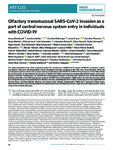Olfactory transmucosal SARS-CoV-2 invasion as a port of central nervous system entry in individuals with COVID-19
Meinhardt, Jenny
Radke, Josefine
Dittmayer, Carsten
Franz, Jonas
Thomas, Carolina
Mothes, Ronja
Laue, Michael
Schneider, Julia
Brünink, Sebastian
Greuel, Selina
Lehmann, Malte
Hassan, Olga
Aschman, Tom
Schumann, Elisa
Chua, Robert Lorenz
Conrad, Christian
Eils, Roland
Stenzel, Werner
Windgassen, Marc
Rößler, Larissa
Goebel, Hans-Hilmar
Gelderblom, Hans R.
Martin, Hubert
Nitsche, Andreas
Schulz-Schaeffer, Walter J.
Hakroush, Samy
Winkler, Martin S.
Tampe, Björn
Scheibe, Franziska
Körtvélyessy, Péter
Reinhold, Dirk
SIegmund, Britta
Kühl, Anja A.
Elezkurtaj, Sefer
Horst, David
Oesterhelweg, Lars
Tsokos, Michael
Ingold-Heppner, Barbara
Stadelmann, Christine
Drosten, Christian
Radbruch, Helena
Heppner, Frank L.
Corman, Victor Max
The newly identified severe acute respiratory syndrome coronavirus 2 (SARS-CoV-2) causes COVID-19, a pandemic respiratory disease. Moreover, thromboembolic events throughout the body, including in the CNS, have been described. Given the neurological symptoms observed in a large majority of individuals with COVID-19, SARS-CoV-2 penetrance of the CNS is likely. By various means, we demonstrate the presence of SARS-CoV-2 RNA and protein in anatomically distinct regions of the nasopharynx and brain. Furthermore, we describe the morphological changes associated with infection such as thromboembolic ischemic infarction of the CNS and present evidence of SARS-CoV-2 neurotropism. SARS-CoV-2 can enter the nervous system by crossing the neural–mucosal interface in olfactory mucosa, exploiting the close vicinity of olfactory mucosal, endothelial and nervous tissue, including delicate olfactory and sensory nerve endings. Subsequently, SARS-CoV-2 appears to follow neuroanatomical structures, penetrating defined neuroanatomical areas including the primary respiratory and cardiovascular control center in the medulla oblongata.
Dateien zu dieser Publikation
Keine Lizenzangabe

